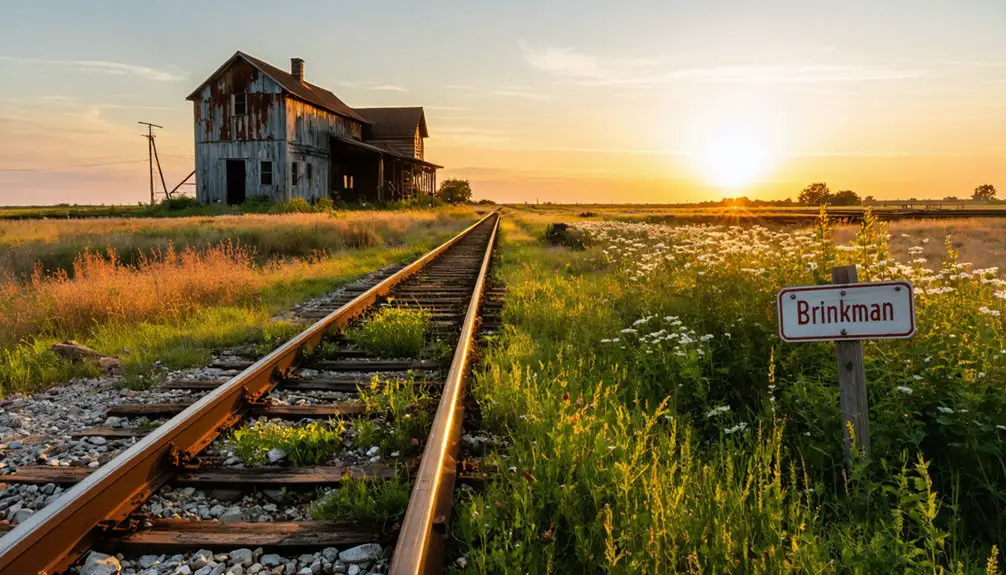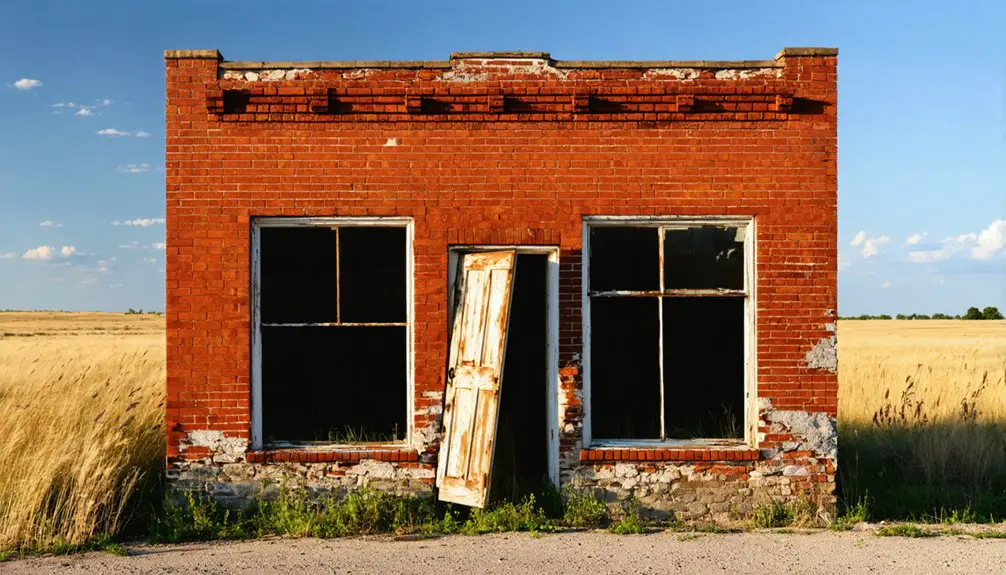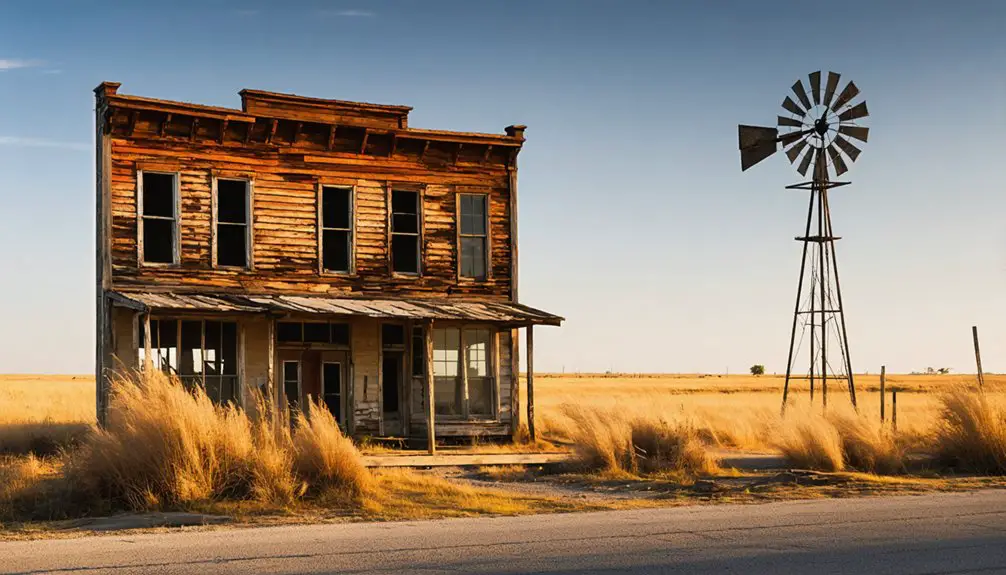You’ll find Brinkman’s haunting remains in Greer County, Oklahoma, where this once-bustling railroad town thrived in the early 1900s. Founded in 1910, it flourished as an agricultural powerhouse with four cotton gins and impressive wheat production, until disasters struck hard. A devastating 1929 fire, bank closure, the Dust Bowl, and eventual railroad removal in 1974 transformed this vibrant community into a ghost town. Its crumbling structures and historical marker now tell tales of prosperity, resilience, and decline.
Key Takeaways
- Brinkman transformed from a thriving railroad town established in 1910 into a ghost town following economic disasters and transportation changes.
- A devastating fire in 1929 destroyed half the business district, while the Great Depression and Dust Bowl forced many residents to abandon the town.
- The removal of the railroad in 1974 and rerouting of Highway 34 in 1931 isolated the town, accelerating its decline.
- The closure of the post office in 1965 marked a significant milestone in Brinkman’s transformation from bustling community to ghost town.
- Today, Brinkman consists of deteriorating structures and scattered residences, with only a historical marker near the cemetery preserving its legacy.
The Rise of a Prairie Market Town
As the Wichita Falls and Northwest Railroad blazed its path across Oklahoma Territory in 1910, it sparked the birth of a vibrant prairie market town called Brinkman.
Originally named Kell, this settlement emerged from the untamed wilderness just seven miles north of Mangum, drawing bold pioneers from Texas and Lebanon who’d ventured west during the momentous 1889 land run and 1893 Cherokee Outlet opening.
You’d have witnessed a remarkable transformation as railroad expansion revolutionized the region. Gone were the days of settlers arriving solely by horse and mule-drawn wagons. Like the historic Ardmore Army Air Field, Brinkman would leave an indelible mark on Oklahoma’s development during wartime.
The town’s strategic location turned it into a bustling agricultural hub, where wheat, cotton, and livestock trades flourished. By the 1920s, Brinkman boasted a thriving commercial district with a bank, hotel, stores, and grain elevators serving 450 students. Like many other boomtowns of Oklahoma, Brinkman’s prosperity would prove temporary.
Agricultural Roots and Railway Connections
Brinkman’s true agricultural might emerged through its remarkable wheat production, outpacing all other Greer County markets combined during peak seasons.
You’d find farmers adapting to changing times, shifting from cotton-dominated fields to embrace crop diversification. Steam powered tractors gradually gave way to internal combustion engines by the 1920s, transforming farming efficiency. In 1907, the region demonstrated its agricultural prowess with 89,603 acres dedicated to cotton production. By 1963, they’d transformed their landscape to include 49,500 acres of wheat, 41,000 of cotton, and substantial sorghum production.
The railroad’s arrival in 1910 revolutionized Brinkman’s agricultural potential, with John Brinkman’s vision connecting local farmers to wider markets.
You’ll appreciate how this rail connection empowered farmers to ship massive quantities of wheat and cotton efficiently. Meanwhile, they’d learned valuable lessons about soil conservation, evolving from erosion-prone cotton to wheat cultivation that left protective residue, preserving their precious topsoil for future generations.
Daily Life in Early Brinkman
Life in early Brinkman bustled with remarkable energy, where you’d find Model T Fords sharing dusty roads with horse-drawn buggies and surreys around 1910. Ford cars dominated the streets with twenty registered vehicles in the community.
You could stroll past the thriving business district, where farmers traded at the grain elevators and townsfolk conducted business at the local bank. The weekly Brinkman Courier kept you informed of the latest happenings. Sadly, the devastating fire in 1929 destroyed much of this once-vibrant commercial center.
Community events centered around the heart of town – the school. With over 450 students by 1925, you’d experience the excitement of sports games, social gatherings, and educational activities that united families.
The post office and hotel served as gathering spots where you’d catch up with neighbors. Despite primitive roads and daily challenges, Brinkman’s residents forged strong bonds through shared experiences and mutual support.
The Golden Years: 1920s Prosperity
You’d have found Brinkman at its most vibrant during the 1920s, when cotton-laden train cars lined the tracks and grain elevators towered over a bustling main street filled with shoppers and merchants.
The town’s strategic position as a railway hub transformed it into a powerhouse of agricultural commerce, where farmers brought their wheat and cotton to market, while livestock traders conducted business at the stockyards.
The bank, hotel, and numerous stores created a thriving commercial district that served both local residents and visitors, with the school’s 450-student enrollment reflecting the prosperity of this golden age.
Like many towns along Route 66, Brinkman’s location made it a natural stop for travelers and traders moving across the state.
This prosperity came to an abrupt end when a major fire in 1929 devastated much of the town.
Peak Cotton Trade Era
The 1920s ushered in a remarkable golden age for cotton production in Brinkman, as Oklahoma’s cotton acreage soared to unprecedented heights.
You’d find four bustling cotton gins processing up to 5,000 bales annually, while the state ranked third nationally in production behind Texas and Mississippi. Despite labor challenges, farmers adapted with cotton innovations like ‘snapping’ techniques to speed up harvesting. The state reached an incredible 3,312,000 planted acres in 1920. The town’s peak enrollment of over 250 students reflected this prosperous period.
As you walked through Brinkman during this era, you’d see cotton buyers evaluating bale quality while farmers negotiated prices at local markets. The prosperity fueled the town’s growth, supporting new schools and infrastructure.
Cotton brought in an impressive $118 million annually from lint sales, making it Oklahoma’s premier cash crop. But beneath this success, you’d notice the backbreaking work of cotton-pullers using kneepads and gloves, toiling in rows three feet apart.
Railway Commerce Hub
While cotton fueled Brinkman’s agricultural might, its railway hub formed the beating heart of the town’s 1920s prosperity.
You’d have witnessed remarkable railway expansion as Brinkman transformed into a bustling center of commerce, where freight efficiency reached new heights through state-of-the-art grain elevators and loading facilities.
The railway’s presence sparked explosive growth, drawing hundreds of families whose children filled the local school to capacity.
You could’ve found everything you needed in town – from banks and hotels to retail stores, all thriving on the constant flow of rail traffic.
The railway didn’t just move wheat and goods; it connected Brinkman’s citizens to broader markets and opportunities, creating a vibrant community where commerce and culture flourished together.
Bustling Main Street Life
During Brinkman’s golden age of the 1920s, Main Street pulsed with an extraordinary blend of commerce and community life.
You’d find townsfolk gathering at the twin grain elevators, where local farmers brought their wheat and cotton harvests. The street’s vibrant mix of businesses served the agricultural economy, while the local bank fueled the town’s prosperity until 1927.
Had you wandered down Main Street, you’d have witnessed bustling social gatherings and community events that brought together settlers from Texas and Lebanon.
The Brinkman Courier, established in 1911, kept everyone connected with weekly news, while the high school’s 450 students brought youthful energy to the thoroughfare.
Main Street wasn’t just a commercial hub – it was the beating heart of a diverse, thriving community in its prime.
Natural and Economic Disasters
You’ll find the 1920s prosperity of Brinkman didn’t last, as the devastating bank closure in 1927 foreshadowed the Great Depression‘s crushing impact on this once-thriving farming community.
The economic catastrophe deepened in 1929 when a massive fire destroyed half of Brinkman’s business district, with most buildings never rebuilt due to the financial strain of the times.
These back-to-back disasters proved too much for many residents, setting the stage for decades of decline that would transform this bustling agricultural hub into a ghost town.
Depression’s Devastating Impact
As the Great Depression tightened its grip on America, Brinkman faced a perfect storm of devastation that would ultimately seal its fate.
The town’s resilience was tested early when its local bank collapsed in 1927, foreshadowing the economic turmoil ahead.
You’ll find three crushing blows that transformed this once-thriving community:
- Agricultural markets plummeted, destroying the wheat and cotton trade that was Brinkman’s lifeblood.
- The merciless Dust Bowl ravaged farmland, leading to severe crop failures and soil erosion.
- Economic migration accelerated as desperate families abandoned their homes in search of work.
Fire Destroys Town Core
The devastating fire of 1929 ripped through Brinkman’s business district, destroying half of its essential commercial core and dealing a crushing blow to the already fragile community.
The fire aftermath revealed the harsh reality that many businesses wouldn’t rebuild, especially with the bank’s departure two years prior. You’d have seen empty lots where thriving shops once stood, as the town’s role as a marketing hub for wheat, cotton, and livestock diminished.
Despite attempts at community resilience, the disaster struck at the worst possible time.
With the Great Depression looming and the new state highway bypassing the town by a mile in 1931, you’d find Brinkman’s chances of recovery slipping away.
The fire had accelerated an economic decline that would ultimately transform this once-bustling town into a shadow of its former self.
Transportation Changes and Isolation

While early settlers initially relied on horse-drawn wagons and buggies to reach Brinkman, transportation methods evolved dramatically throughout the town’s history.
You can trace Brinkman’s transportation evolution from its thriving beginnings to its eventual community isolation through these crucial changes:
- The railroad’s arrival in 1910 transformed Brinkman into a bustling wheat shipping hub, with trains connecting the town to essential markets and bringing new settlers like the Lampert family.
- By 1916, you’d find various automobiles roaming the streets, especially Fords with their narrow tires perfectly suited for the rough local roads.
- Two devastating blows sealed Brinkman’s fate – the 1931 decision to route Highway 34 a mile away from town, followed by the railroad’s complete removal in 1974.
The Post Office’s Final Days
You’ll find that Brinkman’s post office followed the typical pattern of mail service decline seen across rural Oklahoma, as local residents increasingly relied on larger regional postal centers.
During its final operational period, the postmaster handled ever-dwindling mail volumes while maintaining crucial daily tasks like sorting, canceling stamps, and processing money orders.
The post office persisted as an essential community hub until 1965, when, like many small-town post offices of that era, it finally closed its doors.
Mail Service Decline Pattern
As Brinkman’s population dwindled in the early 1900s, its post office faced mounting pressure from a broader regional trend of postal service consolidation. You would’ve witnessed the transformation of rural connectivity as neighboring post offices closed between 1900 and 1906, forcing residents to adapt to a new reality.
The changes brought three significant impacts to your community:
- Your mail got redirected to larger towns like Mangum, Eldorado, or Hollis.
- You’d need to travel further to pick up your correspondence.
- Your business communications slowed down considerably.
This postal consolidation reflected the territory’s modernization efforts, as rural free delivery routes began replacing smaller post offices. You’ll recognize this pattern throughout Oklahoma’s early history – it’s the story of progress reshaping frontier communities, sometimes at the cost of local independence.
Last Postmaster’s Daily Tasks
Dawn broke each morning as Brinkman’s last postmaster opened the weathered post office door, stepping into a daily ritual that would soon fade into history.
You’d find them meticulously inspecting incoming mail, organizing route deliveries, and preparing the day’s cash drawer for the handful of loyal customers who’d still venture in for stamps and money orders.
The postmaster duties grew more challenging as regional transportation schedules slowed and overnight mail holdovers increased.
Mail sorting became a delicate balance of managing delayed deliveries while maintaining service standards.
As the day wound down, you’d see them reconciling accounts, securing undelivered packages, and locking up – knowing that each sunset brought Brinkman’s post office closer to its final days in 1965.
Community Hub Until 1965
The Brinkman Post Office stood as the beating heart of the community right until its final day of operation in 1965. You’d find this hub of postal significance bustling with daily community interactions, as residents gathered to collect mail, exchange news, and conduct business.
The facility’s role extended far beyond simple mail delivery, enabling crucial connections to the outside world through commerce and communication.
During its final years, you would’ve witnessed three critical functions:
- Supporting local trade by facilitating essential business correspondence
- Maintaining community bonds through daily social gatherings
- Processing agricultural market updates and financial transactions
When State Highway 34 bypassed Brinkman in 1953, you could sense the town’s decline accelerating.
The post office’s closure in 1965 marked the end of an era, signaling Brinkman’s inevitable shift toward ghost town status.
Legacy in Greer County
While Brinkman’s physical structures have largely disappeared, its legacy endures throughout Greer County as a proof of Oklahoma’s agricultural and ranching heritage.
You’ll find Brinkman heritage etched into the region’s identity through its historical marker near the cemetery, which stands as a symbol of the pioneering spirit that shaped this land.
The town’s story mirrors countless other communities that rose and fell with the rhythms of wheat harvests, railroad decisions, and economic tides.
In Greer history, Brinkman’s transformation from a bustling agricultural center to a ghost town serves as a powerful reminder of how infrastructure changes, environmental challenges, and economic forces can reshape rural communities.
The town’s tale continues to captivate those seeking to understand Oklahoma’s dynamic past.
What Remains Today

Modern-day visitors to Brinkman encounter a landscape that’s markedly different from its prosperous past. The once-bustling town has transformed into a haunting ghost town, where nature steadily reclaims what humans left behind.
You’ll find just a handful of deteriorating structures and scattered residences, with most of the original buildings having succumbed to time.
The historical significance of Brinkman is preserved through:
- A commemorative marker installed in 2012, marking the town’s former location
- A few surviving buildings that stand as silent witnesses to the community’s history
- The surrounding agricultural lands that tell the story of the area’s economic evolution
If you’re planning to explore, you’ll need to come prepared – there aren’t any services available, and the state highway now bypasses the site by about a mile.
Preserving Brinkman’s Memory
Efforts to preserve Brinkman’s legacy have evolved into a multi-faceted campaign of documentation, research, and public education.
You’ll find extensive records in the University of Oklahoma’s Western History Collection, where over 1,200 sources tell Brinkman’s story through historical storytelling. The Oklahoma Historical Society’s marker program guarantees the town’s significance lives on, highlighting its 1910 founding and evolution from a bustling wheat and cotton center to a ghost town.
Digital preservation efforts now make Brinkman’s history accessible through online archives, featuring photographs, postal records, and WPA documents.
These resources chronicle the town’s rise and fall, from its peak in the 1920s through its decline during the Great Depression. Thanks to dedicated historians and preservationists, you can explore Brinkman’s past through various platforms, ensuring its memory endures for future generations.
Frequently Asked Questions
Are There Any Ghost Stories or Legends Associated With Brinkman?
You won’t find documented haunted history or well-known local legends about this place – while abandoned buildings might spark ghost stories, there’s no verified paranormal activity in historical records.
What Was the Peak Population of Brinkman During Its Most Prosperous Years?
While exact records aren’t available, you’ll find Brinkman’s peak population reached between 1,000-2,000 residents during the 1920s, evidenced by the 450-student school enrollment before the town’s dramatic population decline began.
Did Any Famous or Notable People Ever Live in Brinkman?
You won’t find any famous residents in historical records, though John Brinkman, Joseph Kemp, and Frank Kell were notable figures who shaped the town’s significance through their railroad development work.
Can Visitors Legally Explore the Remaining Structures in Brinkman Today?
With 100% of Brinkman’s structures lacking clear access permissions, you can’t legally explore without verifying ownership. Exploration regulations require landowner approval, and visitor safety concerns make unauthorized entry risky and potentially illegal.
What Were the Original Land Prices When Brinkman Was First Established?
You’d find land values varied, with homesteads likely costing $1.25 per acre and town lots near the railroad commanding higher prices, though exact records of historical significance haven’t survived.
References
- https://www.youtube.com/watch?v=5d-wHDTIbb0
- https://en.wikipedia.org/wiki/List_of_ghost_towns_in_Oklahoma
- https://kids.kiddle.co/Brinkman
- https://www.texasescapes.com/TexasPanhandleTowns/WillowOklahoma/WillowOklahoma.htm
- https://www.okhistory.org/publications/enc/entry?entry=GR025
- https://www.okhistory.org/about/markers?action=search
- https://okgenweb.net/~okgreer/brnktrans.html
- https://www.ghosttowns.com/states/ok/brinkman.html
- https://okgenweb.net/~okgreer/brnkfarm.html
- https://www.loquis.com/en/loquis/6784378/Brinkman+Oklahoma



